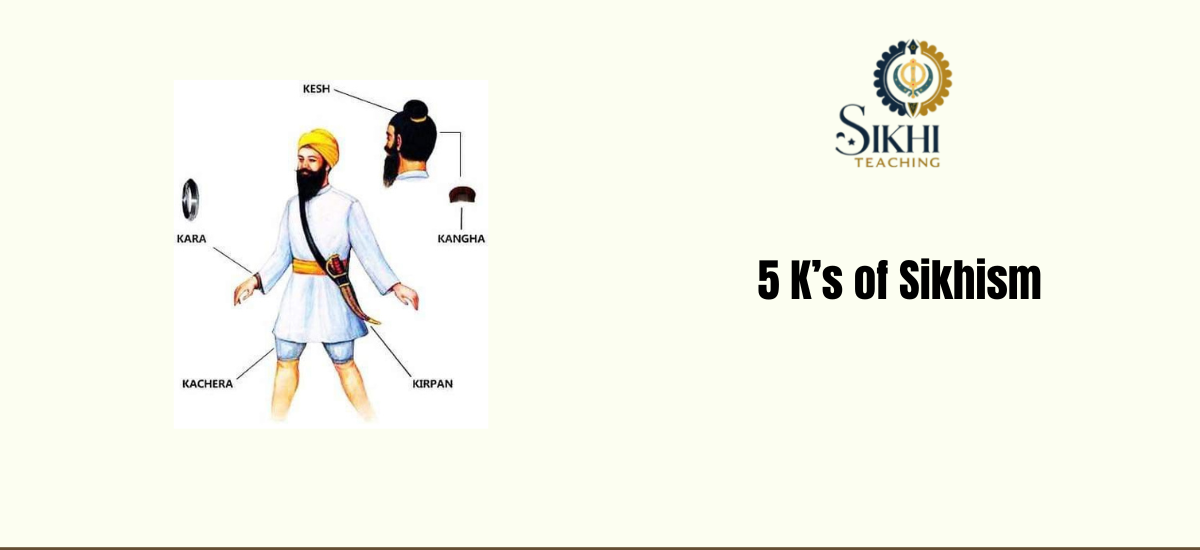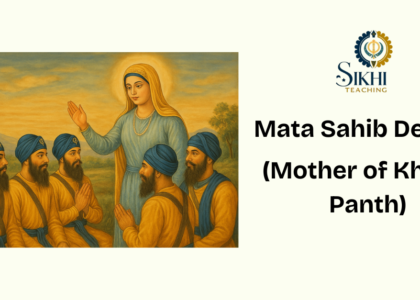What are the Five Ks, then? Every Sikh who is initiated is required to wear the Five Ks, which are five unique articles of faith (Amritdhari). These are not merely insignificant items; they have profound significance and serve as a reminder of Sikh identity, principles, and discipline. Consider them to be symbols that direct a Sikh’s thoughts, behaviors, and daily life.
Historical Origin of the Five Ks in Sikhism
The creation of the Khalsa at the Vaisakhi festival in 1699 by Guru Gobind Singh Ji, the tenth Sikh Guru, is when the Five Ks saga began. In order to live a disciplined, courageous, and spiritual life, he urged his followers to undergo Amrit (initiation). He gave them these five Ks to symbolize their identity and solidarity. As a sign of their dedication to their religion, Sikhs who join the Khalsa have worn them ever since.

The Five Ks: Symbolism & Meaning
Kesh (Uncut Hair): Meaning & Significance
Uncut hair is what kesh means. Sikhs honor the way God created us by wearing their hair naturally. Sikhs believe that living frugally and submitting to God’s will is the key to not cutting one’s hair. For this reason, Sikh men frequently hide their Kesh with turbans.
Kangha (Comb): Symbol of Cleanliness
The Kangha is a little wooden comb that Sikhs wear in their hair. It acts as a reminder to people to keep both their outside and interior spaces tidy and orderly. The intellect is as clean as the hair. The method is simple yet efficient.
Kara (Steel Bracelet): Reminder of Moral Conduct
The Kara is a wristband made of steel. It reminds Sikhs of God’s boundless character because it is circular and has no beginning or conclusion. It also serves as a moral checkpoint, a continual reminder to reconsider actions before taking them.
Kirpan (Sword): Duty & Self-defense
The Kirpan is a little dagger or blade. It stands for courage, fairness, and defense of the helpless. Sikhs carry it as a symbol of their duty to defend others when necessary and to stand up for what is right, not as a weapon to attack.
Kachera (Shorts): Readiness & Self-control
The Kachera are unique shorts made of cotton. They represent preparation, self-control, and modesty. They also made practical sense in the past because Sikhs had to be prepared to move and defend swiftly.
Quick Comparison Table: The Five Ks at a Glance
| K | Meaning | Symbolism |
|---|---|---|
| Kesh | Uncut Hair | Accepting God’s will |
| Kangha | Comb | Cleanliness and order |
| Kara | Steel Bracelet | Reminder of good deeds |
| Kirpan | Sword | Courage and justice |
| Kachera | Shorts | Modesty and readiness |
Modern Relevance of the Five Ks
Legal Considerations for Kirpan in Different Countries
Sikhs are now found all over the world. Because the Kirpan is regarded as a weapon in some nations, carrying it might lead to legal disputes. Because they recognize its religious significance, several governments permit Sikhs to carry tiny copies of it.
Wearing the Five Ks as a Woman in Sikhism
Contrary to popular belief, Sikh men are not the only ones who don the Five Ks. They are also worn by Amritdhari Sikh women. The Five Ks are not gender-specific; they apply to everyone.
Spiritual & Ethical Significance of the Five Ks
Deeper down, the Five Ks are more than just tangible items. They serve as daily reminders to live a life that is honest, brave, modest, and based on faith. They help Sikhs stay rooted in their beliefs, community, and God.
Practical Tips: Caring for Your Five Ks
Kesh: Wash and tie your hair neatly.
Kangha: Keep it clean and use it daily.
Kara: Wear it all the time—it doesn’t rust!
Kirpan: Respect it, never misuse it.
Kachera: Keep them clean, change daily.
Common Misconceptions about the Five Ks
“Only men wear the Five Ks.” → False! Women wear them too.
“Kirpan is just a weapon.” → No, it’s a symbol of protection and justice.
“The Five Ks are old-fashioned.” → They are still very relevant today, reminding Sikhs of their faith and values.



